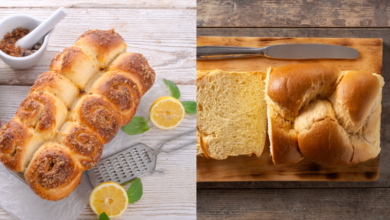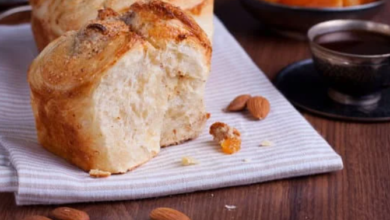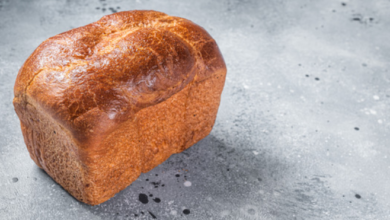Brioche Perfection with All-Purpose Flour

What To Know
- In the bowl of a stand mixer fitted with the dough hook attachment, combine the flour, sugar, salt, and yeast.
- Transfer the dough to a lightly greased bowl, cover it with plastic wrap, and let it rise in a warm place for 1-2 hours, or until doubled in size.
- Let the brioche cool in the pan for a few minutes before transferring it to a wire rack to cool completely.
Brioche, the epitome of French pastry, is renowned for its luxurious texture and buttery flavor. Its signature golden-brown crust and airy crumb make it a delight for any palate. But can you achieve this culinary masterpiece with all-purpose flour, the workhorse of many kitchens? Let’s delve into the secrets of brioche and explore whether all-purpose flour can live up to the task.
The Role of Flour in Brioche
Flour plays a crucial role in the structure and texture of brioche. It provides the framework for gluten development, which gives the pastry its elasticity and chewiness. Strong bread flour, with its high protein content, is typically the preferred choice for brioche due to its ability to form strong gluten strands.
Can I Use All-Purpose Flour for Brioche?
Yes, you can make brioche with all-purpose flour. However, it is important to note that the texture and flavor will differ slightly from that of brioche made with bread flour. All-purpose flour has a lower protein content, resulting in less gluten development. This means that the brioche will be less chewy and may have a slightly denser crumb.
Adjustments for Using All-Purpose Flour
To compensate for the lower protein content of all-purpose flour, you will need to make some adjustments to the recipe. Here are a few tips:
- Increase the flour quantity: As all-purpose flour absorbs less water than bread flour, you may need to add slightly more flour to the dough to achieve the desired consistency.
- Add vital wheat gluten: Vital wheat gluten is a concentrated form of protein that can be added to all-purpose flour to increase its gluten strength. This will help to improve the texture and elasticity of the brioche.
- Knead for longer: Kneading develops gluten, so it is important to knead the dough for a slightly longer time when using all-purpose flour. This will help to form stronger gluten strands.
Recipe Modifications
Here is a modified brioche recipe for all-purpose flour:
Ingredients:
- 3 cups (360g) all-purpose flour, plus more for dusting
- 1/2 cup (100g) sugar
- 1 teaspoon (5g) salt
- 1 packet (2 1/4 teaspoons) active dry yeast
- 1 cup (240ml) warm milk (105-115°F)
- 2 large eggs, at room temperature
- 1/2 cup (113g) unsalted butter, softened
Instructions:
1. In the bowl of a stand mixer fitted with the dough hook attachment, combine the flour, sugar, salt, and yeast.
2. Add the warm milk and eggs and mix on low speed until a dough forms.
3. Add the softened butter and continue mixing on medium speed for 5-7 minutes, or until the dough becomes smooth and elastic.
4. Transfer the dough to a lightly greased bowl, cover it with plastic wrap, and let it rise in a warm place for 1-2 hours, or until doubled in size.
5. Punch down the dough and divide it into 12 equal pieces.
6. Shape the pieces into balls and place them in a greased 9×13 inch baking pan.
7. Cover the pan with plastic wrap and let the dough rise again for 1 hour, or until doubled in size.
8. Preheat the oven to 375°F (190°C).
9. Bake the brioche for 25-30 minutes, or until golden brown.
10. Let the brioche cool in the pan for a few minutes before transferring it to a wire rack to cool completely.
Tips for Success
- Use high-quality ingredients, especially the butter.
- Allow the dough to rise in a warm, draft-free place.
- Do not over-knead the dough, as this can result in a tough brioche.
- Bake the brioche until it is golden brown and sounds hollow when tapped.
- Let the brioche cool completely before slicing and serving.
Variations
- Chocolate brioche: Add 1/2 cup (60g) of chopped semisweet chocolate to the dough.
- Cinnamon brioche: Add 1 tablespoon (15g) of ground cinnamon to the dough.
- Fruit brioche: Add 1/2 cup (100g) of dried fruit, such as raisins, cranberries, or apricots, to the dough.
Recommendations: Embracing the Versatility of Brioche
While bread flour is the preferred choice for brioche, all-purpose flour can certainly be used with some adjustments. By following the tips and recipe modifications outlined in this post, you can create a delicious and satisfying brioche that will impress your family and friends. So, embrace the versatility of this classic pastry and indulge in the buttery, airy goodness of brioche, regardless of the type of flour you have on hand.
Basics You Wanted To Know
Can I substitute bread flour for all-purpose flour in this recipe?
Yes, you can substitute bread flour for all-purpose flour in a 1:1 ratio. However, the brioche may be slightly chewier and have a denser crumb.
Can I make brioche without a stand mixer?
Yes, you can make brioche by hand. However, it will require more time and effort to knead the dough.
How do I store brioche?
Brioche can be stored at room temperature for up to 2 days. For longer storage, wrap it tightly in plastic wrap and freeze it for up to 2 months.





